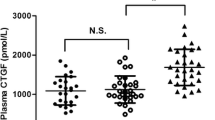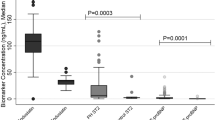Abstract
Background
Endothelial activation and vascular inflammation are thought to be the mechanisms of pulmonary hypertension. Increased expression of the intercellular adhesion molecule (ICAM-1) and raised serum level of its soluble form (sICAM-1) are found in various conditions associated with endothelial activation.
Methods
Serum samples from 31 children (14 boys and 17 girls; age, 4.9 ± 4.6 years) with congenital heart disease (CHD) collected at the time of cardiac catheterization were analyzed for sICAM-1 level. Uni- and multivariable stepwise linear regression analyses were performed for the following variables against the sICAM-1 level: age, hemoglobin, serum creatinine, systemic arterial pressure (SAP), pulmonary arterial pressure (PAP), pulmonary blood flow (Qp) and resistance (Rp), systemic blood flow (Qs) and resistance (Rs), Qp/Qs, Rp/Rs, and pulmonary and systemic oxygen saturation.
Results
The sICAM-1 levels in children who had CHD with and without pulmonary hypertension were 411 ± 110 and 344 ± 81 ng/ml, respectively (p = 0.11). In the univariable models, age, serum creatinine, systolic PAP, mean PAP, diastolic PAP, Rp, and Rp/Rs were significantly correlated with sICAM-1 level. In the multiple stepwise regression model, only mean PAP remained as an independent predictor of sICAM-1 level (r = 0.55; p = 0.002).
Conclusion
Children with CHD and pulmonary hypertension had a trend toward elevated sICAM-1 compared with CHD children who had no pulmonary hypertension. A linear correlation was found between mean pulmonary arterial pressure and sICAM-1 level.



Similar content being viewed by others
References
Bakouboula B, Morel O, Faure A et al (2008) Procoagulant membrane microparticles correlate with the severity of pulmonary arterial hypertension. Am J Respir Crit Care Med 177:536–543
Bencze J, Kiss RG, Toth-Zsamboki E et al (2006) Inverse correlation between coronary blood flow velocity and sICAM-1 level observed in ischemic heart disease patients. Atherosclerosis 188:142–149
Bridges N, Freed MD (1995) Cardiac catheterization. In: Emmanouilides GC, Riemenschneider TA, Allen HD, Gutgesell HP (eds) Heart disease in infants, children, and adolescents. Williams & Wilkins, Inc, Baltimore, pp 310–328
Brooks AR, Lelkes PI, Rubanyi GM (2002) Gene expression profiling of human aortic endothelial cells exposed to disturbed flow and steady laminar flow. Physiol Genomics 9:27–41
Cella G, Saetta M, Baraldo S et al (2005) Endothelial cell activity in chronic obstructive pulmonary disease without severe pulmonary hypertension. Clin Appl Thromb Hemost 11:435–440
Chien S, Li S, Shyy YJ (1998) Effects of mechanical forces on signal transduction and gene expression in endothelial cells. Hypertension 31:162–169
Diller GP, Gatzoulis MA (2007) Pulmonary vascular disease in adults with congenital heart disease. Circulation 115:1039–1050
Hartford M, Wiklund O, Mattsson Hulten L et al (2006) CRP, interleukin-6, secretory phospholipase A2 group IIA, and intercellular adhesion molecule-1 during the early phase of acute coronary syndromes and long-term follow-up. Int J Cardiol 108:55–62
Haworth SG (2006) Role of the endothelium in pulmonary arterial hypertension. Vascul Pharmacol 45:317–325
Hjelstuen A, Anderssen SA, Holme I et al (2006) Markers of inflammation are inversely related to physical activity and fitness in sedentary men with treated hypertension. Am J Hypertens 19:669–675 (discussion 676–667)
Kato GJ, Martyr S, Blackwelder WC et al (2005) Levels of soluble endothelium-derived adhesion molecules in patients with sickle cell disease are associated with pulmonary hypertension, organ dysfunction, and mortality. Br J Haematol 130:943–953
Keaney JF Jr, Massaro JM, Larson MG et al (2004) Heritability and correlates of intercellular adhesion molecule-1 in the Framingham Offspring Study. J Am Coll Cardiol 44:168–173
Kobayashi H, Yamataka A, Okazaki T et al (2004) Increased levels of circulating adhesion molecules in neonates with congenital diaphragmatic hernia complicated by persistent pulmonary hypertension. Pediatr Surg Int 20:19–23
Labarrere CA, Nelson DR, Miller SJ et al (2000) Value of serum-soluble intercellular adhesion molecule-1 for the noninvasive risk assessment of transplant coronary artery disease, posttransplant ischemic events, and cardiac graft failure. Circulation 102:1549–1555
Luc G, Arveiler D, Evans A et al (2003) Circulating soluble adhesion molecules ICAM-1 and VCAM-1 and incident coronary heart disease: The PRIME Study. Atherosclerosis 170:169–176
Madej A, Okopien B, Kowalski J et al (2005) Plasma concentrations of adhesion molecules and chemokines in patients with essential hypertension. Pharmacol Rep 57:878–881
Nagel T, Resnick N, Atkinson WJ et al (1994) Shear stress selectively upregulates intercellular adhesion molecule-1 expression in cultured human vascular endothelial cells. J Clin Invest 94:885–891
Rabinovitch M (2001) Pathophysiology of pulmonary hypertension. In: Allen HD, Gutgesell HP, Clark EB, Driscoll DJ (eds) Moss and Adams’ heart disease in infants, children, and adolescents. Lippincott Williams & Wilkins, Philadelphia, pp 1311–1346
Tesfamariam B, DeFelice AF (2007) Endothelial injury in the initiation and progression of vascular disorders. Vascul Pharmacol 46:229–237
Walpola PL, Gotlieb AI, Cybulsky MI, Langille BL (1995) Expression of ICAM-1 and VCAM-1 and monocyte adherence in arteries exposed to altered shear stress. Arterioscler Thromb Vasc Biol 15:2–10
Wilhelmi MH, Leyh RG, Wilhelmi M, Haverich A (2005) Upregulation of endothelial adhesion molecules in hearts with congestive and ischemic cardiomyopathy: immunohistochemical evaluation of inflammatory endothelial cell activation. Eur J Cardiothorac Surg 27:122–127
Yin WH, Chen JW, Jen HL et al (2003) The prognostic value of circulating soluble cell adhesion molecules in patients with chronic congestive heart failure. Eur J Heart Fail 5:507–516
Acknowledgments
This study was funded by the Rachadapiseksompotch Grant, Faculty of Medicine, Chulalongkorn University and the Thailand Research Fund and Commission on Higher Education (Dr. Apichai Khongphatthanayothin, RMU4980019). The authors thank the staff at the Cardiac Catheterization Laboratory and the Center of Excellence in Viral Hepatitis Research, Faculty of Medicine, Chulalongkorn University for specimen collection and laboratory assistance.
Author information
Authors and Affiliations
Corresponding author
Rights and permissions
About this article
Cite this article
Sungprem, K., Khongphatthanayothin, A., Kiettisanpipop, P. et al. Serum Level of Soluble Intercellular Adhesion Molecule-1 Correlates with Pulmonary Arterial Pressure in Children with Congenital Heart Disease. Pediatr Cardiol 30, 472–476 (2009). https://doi.org/10.1007/s00246-008-9374-1
Received:
Revised:
Accepted:
Published:
Issue Date:
DOI: https://doi.org/10.1007/s00246-008-9374-1




